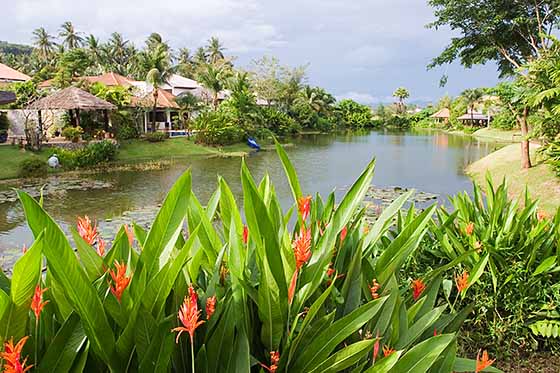Places In Thailand - Page 2
Khaolak
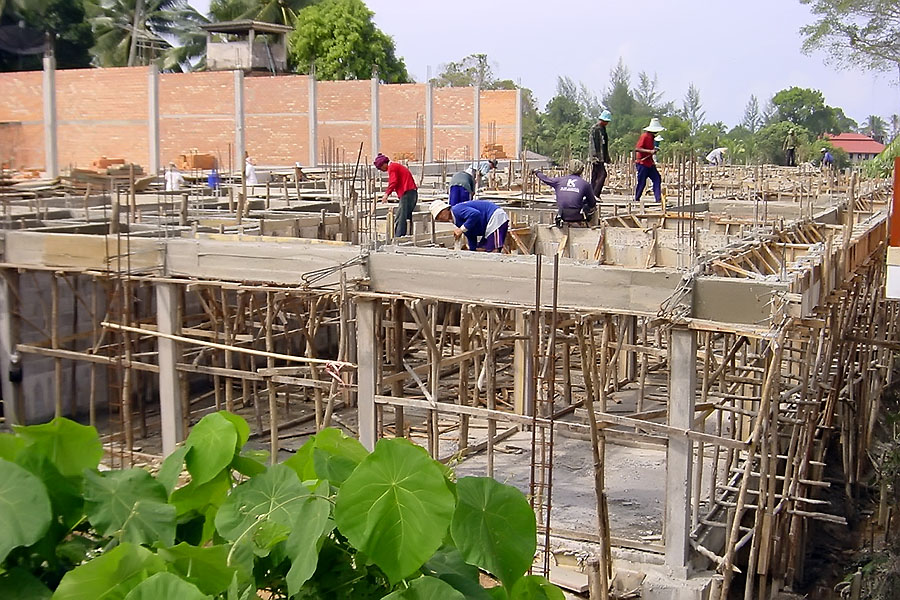
A huge amount of development had been taking place in Khaolak before the tsunami struck
In the winter of 2001/2002 I was in Chiang Mai and met a German couple who I became friends with. After Chiang Mai I already had a ticket to fly down to Phuket but to be honest I wasn't keen on going to Phuket again. They told me about Khaolak and it sounded good, at least worth a look, and that's where they were headed. When I got to Phuket airport instead of going south to the Phuket beaches I went north to Khaolak where I joined them.
I loved it there. I had never heard of Khaolak before and, judging from the lack of British people, neither had many other Brits. There were quite a few German and Scandinavian tourists but that is always the way - they always seem to hear about these 'new' places first.
I returned again in November 2002, then again in February 2003 and then again in November 2003. In the past in Thailand I have returned to places after they have completely changed, such as Pattaya and Phuket, but this was my first experience of seeing an area undergo change. In just under two years I visited four times, a couple of times for fairly lengthy stays, and it wasn't an entirely pleasant experience seeing what was happening.
On my first visit I was most impressed. The area consisted of a series of pleasant beaches that got progressively quieter the further north you went and inland was a National Park. There were a few large, quite upmarket resorts catering to families and couples and an assortment of bungalows for budget travellers. The people staying at the big resorts seemed to stay inside most of the day, lounging around the pool and eating in the hotel restaurants. The restaurants outside were quiet and friendly, there were a few bars but they weren't loud and there weren't any bar girls. There were a few dive shops mainly specialising in trips to the Similans. The Similan Islands offer fantastic diving and Khaolak is about the nearest place on the mainland to get to them. I found a comfortable place to stay, a few great restaurants to eat at, went on a live aboard dive trip to the Similans and generally had a great time. If I got bored I'd jump on the bus down to Phuket but whenever I got to Phuket I'd hate it almost straight away for what it had turned into.
Things were never going to stay the same in Khaolak. There may still be a lot of people who like what Patong Beach has to offer but there are far more people who cannot stand the tackiness and lack of taste that exists there now. They want a quieter, more relaxed environment and this is what Khaolak offers. What Khaolak has in its favour, in addition to beautiful scenery, is that the transport infrastructure is already there. It's about the same distance north of Phuket airport as the Phuket beaches are south of Phuket airport and there is a decent road from the airport.
At about the same time as Khaolak's development took off the Thai authorities decided they wanted to rid the country of its sordid reputation and attract a 'better' class of tourist. This has affected the type of accommodation and entertainment venues that have been allowed to be built there. On my second, third and fourth visits I saw an incredible amount of development going on. It was mind boggling. Many of the buildings are large, fancy hotels and I was told on my last visit that one new place would be charging Bt20,000 or more a night. I think this might have been the new Le Meridien hotel. It would appear that independent bar licenses have been quite restricted. With all the new building I didn't see any new bars being built and there still no bar girls but eventually word will get out and they will appear.
Even the budget bungalow operations appear to have jumped on the bandwagon. When I was last there a number of them were upgrading facilities to include hot showers and air-conditioning. On my first visit I hardly saw any backpackers. I think though that in a new edition of the Lonely Planet Islands and Beaches guide an entry for Khaolak was added. This resulted in backpackers getting off the bus at Khaolak between Phuket and Surat Thani. I'd see them get off carrying their Lonely Plane guides, shrugging off any Thai attempting to help them find accommodation because everything they needed to know was in their guide book.
Within two years Khaolak changed from somewhere I loved to somewhere I started to dislike. On my first trip I found a perfect little thatched restaurant that overlooked a natural pond. There were lots of fish in the pond and exotic looking birds would come down to snack on the fish. It was extremely peaceful, located on the beach road with hardly another building in sight, and to me it was quite idyllic.
On my last trip I found that the restaurant had been torn down and the pond filled so that ugly bungalows could be built. All along the beach road new buildings had been built. It was upsetting for me and I imagined that it would be upsetting for the people who owned the restaurant. I couldn't have been more wrong though. They are as pleased as Punch because of the money they will get from the bungalows and destroying a beautiful environment is totally inconsequential.
Update September 2004: I am pleased to have some good things to say about Khaolak again. On my first visit the dominant colour in the area was green as it is so lush there. On subsequent visits red had become the dominant colour. The earth is a vibrant red colour and the bulldozers had exposed mountains of it as they ripped up the ground to build new buildings. The process horrified me.
On my visit in September 2004 the development seems to have slowed a bit. Some of the new hotels are now complete and they are actually very elegant and blend in well with the environment. I took a look around La Flora and was most impressed. There has been a deliberate effort apparently to prevent Khaolak turning into another Phuket.
As I said above, the hotels and resorts being built are upmarket to attract a more upmarket type of tourist. It's not all pretty though. There are ugly buildings being erected and the destruction of some of the natural habitat is inexcusable. One girlie bar has appeared but it is fairly low key and there is a lot of local opposition to this type of thing.
Update April 2005: It is now four months since the tsunami struck on 26th December 2004 which resulted in a huge loss of life and shocked the world. Khaolak, a place I have become familiar with in recent years, was devastated. I have held back from making any comments but now that the story no longer dominates the news, what is happening?
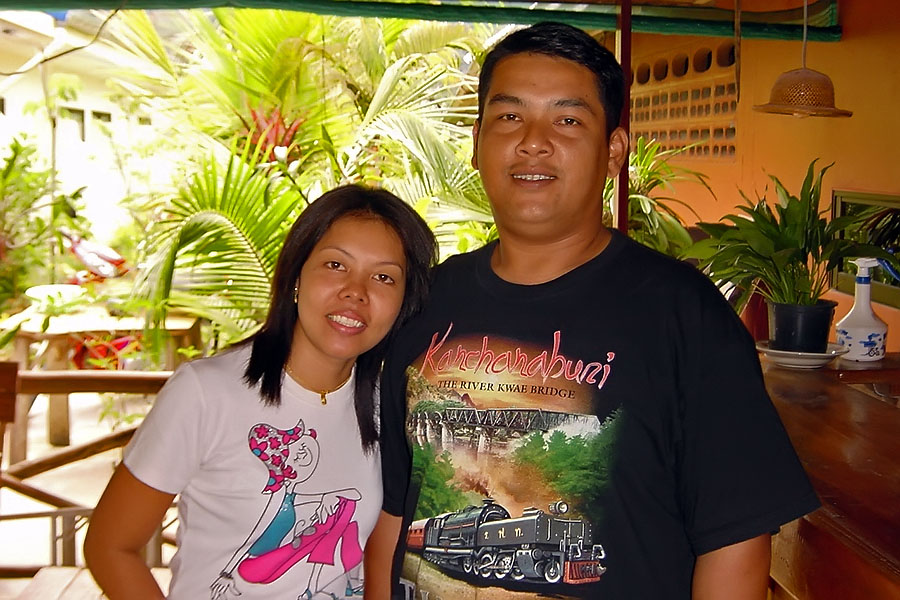
Chang Noi and Deng; their planned marriage never materialised
I discovered in April 2005 that a friend of mine lost his life on that awful day. Chang Noi, as he was affectionately known, was a big guy with a big heart. He was a quiet man but never reluctant to do someone a good turn and he always had a smile on his face. He will be sadly missed.
He was the fiance of my friend, Deng. Along with Deng's parents they ran a small restaurant near the beach at Bang Niang and last year they had some bungalows built to cash in on the area's growth as a tourist destination. At this point I have to point out I was unimpressed with all the development and in particular with what had been done at their restaurant but in Thailand people have to do what is necessary in order to survive.
When I spoke to Deng after finally tracking down her phone number she told me of Chang Noi's death. She told me how the restaurant, new bungalows and the hotel opposite (one of my favourites) had been completely washed away.
In a single day she lost her partner and the entire family lost their livelihood. Her parents have stayed in the area where her father has some other business interests and she has moved to Bangkok to seek work. The idyllic lifestyle she once had is gone and she has been forced to leave her family to live alone in the capital so she can earn a living.
Immediately after the disaster, while the world was watching, the Thai government made a huge effort. Sadly, that seems to have died down a little now with many people saying they have still not received the long-term financial aid and support they need. Interestingly, foreign governments and aid agencies seem to be doing more for those affected than the Thai government.
There was lots of political rhetoric after the tsunami about building a warning system but then a huge argument erupted over where it should be based. Everyone involved in the discussion wanted it in their country which gives an indication of the real motives for the discussions.
The big tsunami shouldn't have come as a complete surprise. By chance, I came across an old newspaper I'd kept from 13 November 2004. An article in it reported an earthquake measuring 6.0 on the Richter scale which jolted the island of Alor in Indonesia the previous day. 16 people were killed, 70 injured and the report said it triggered a tsunami.
Patong Beach in Phuket now has lookout towers and sirens to warn of future tsunamis but, as The Nation points out, this doesn't help any other areas and the chances of another tsunami occurring at Patong are about the same as winning the lottery, being hit on the head by a coconut and dying all on the same day. Nonetheless, it all makes for good political capital.
The planned tsunami system which should be operational in 2006 will cost Bt800 million. A memorial to be built in Khaolak will cost Bt500 million. Allegations of officials helping themselves to the disaster fund money have already started in Phuket. Meanwhile the people who need homes and fishing boats in order to resurrect their lives are still waiting.
It's all quite sad and perhaps the biggest lesson to avoid such huge loss of life has already been learnt. Among all the dead bodies, not one dead animal was found. Upon sensing the imminent danger the animals must all have fled inland. When a huge wave appears out at sea it might make more sense to do the same as the animals rather than stand on the beach taking pictures with a digital camera as it gets closer.
Update May 2005: Finally I found some free time to take a trip back to Khaolak. It wasn't a journey I was particularly looking forward to and indeed, it turned out to be quite depressing. However, I wanted to check up on friends I had been unable to contact and I wanted to see how things looked now after the tsunami.
Khaolak Revisited gives some history about my relationship with the area and an account of what I found after the tsunami. I have included photos taken before and after 26th December 2004.
Book Your Hotel In Khaolak
Koh Lanta
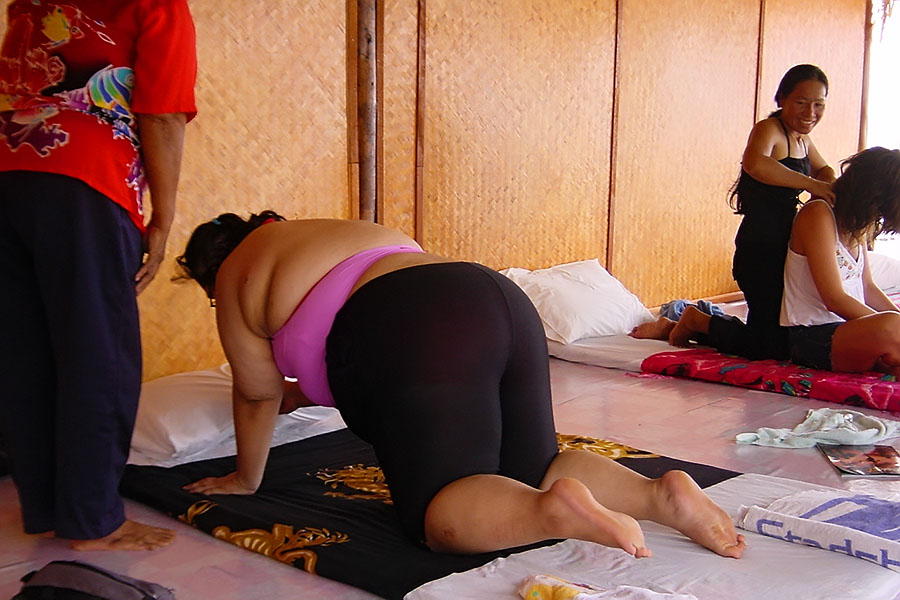
Getting massaged in Koh Lanta
Is this one of the few remaining 'Tropical Paradises' in Thailand or is it perhaps the greediest place in Thailand?
At the dawn of 2006 I was in Lanta to greet in the New Year. It was my first visit but I'd heard a lot about the island previously, mostly positive.
However, I tend to have different opinions about places in Thailand compared to the majority of visitors. You can read what I thought by clicking here.
Book Your Hotel In Koh Lanta
Koh Phi Phi

The constant crowds these days have taken away the magic of visiting Phi Phi but it is still an immensely beautiful location
I honestly can't remember when I first visited Phi Phi Island. It was a day trip from Phuket so it would have been either 1992 or 1996. In either case, it was a beautiful place. There are in fact a few islands but Phi Phi Don and Phi Phi Leh are the ones visitors go to. The boat was a big old tug and took a while to get there. We stopped at Viking Cave and got off to look inside the cave where they collect swallows nests for birds nest soup. After this we continued to Phi Phi Don to go snorkelling in crystal clear water and have lunch.
There weren't a huge amount of tourists around and most were day trippers with evidence of a few people staying on the island, I noticed a few very basic bungalows around. My impressions of Phi Phi then were that it was almost the perfect tropical island. Palm trees hung over perfect white beaches and the sea was that wonderful aquamarine blue colour, that you see in travel brochures, and teemed with tropical fish.
With the general increase in tourism to Thailand, Phi Phi was never going to stay quiet for long as it is such a beautiful place but its death knell came in 1999 with the filming of 'The Beach'. The Alex Garland novel (which starts off quite well but loses its way about two-thirds of the way through, and is familiar with all backpackers) was to be made into a film and filmed in Thailand with Phi Phi Leh used as one of the main locations. Just as 'James Bond Island' in Phang-Nga was to be invaded by tourists years after the making of the film that used this location 'The Beach' has done the same thing for Phi Phi.
On subsequent trips to Thailand I'd heard what was happening to Phi Phi and didn't feel inclined to go back but I eventually returned in November 2003. By this time there were thousands of day trippers going to the island from both Phuket and Krabi in high-powered speedboats. We stopped at Phi Phi Leh to look at the Viking Cave from the boat but visitors were no longer allowed to go inside the cave. It was a bit of the shame but with thousands of visitors every day a very sensible ruling.
The islands are still stunningly beautiful. What has been in existence for thousands of years is not going to be destroyed in a few years by people. What has changed though since my first visit is the sheer number of visitors. The boat took us from bay to bay and in every location there were between 30 and 50 other boats. On small beaches there were hundreds of people milling around, especially at the location where 'The Beach' was filmed. We stopped for lunch at Phi Phi Don but there was a continual procession of people walking around. It's beautiful but if you want some peace and seclusion probably not the best place.
I should point out that my last visit was in the high season. If you can, visit in the low season. The low season in Thailand is fantastic. The weather is cooler, there aren't thousands of tourists everywhere and prices are lower.
Book Your Hotel In Koh Phi Phi
Koh Samui

Samui in 2002 before mass tourism completely took over
Koh Samui was one of the places I visited on my first trip to Thailand in 1987. I went with a friend who knew a bit about the backpacking scene and he had heard about Samui whereas I had not, and neither had most other people.
We stayed at Lamai Beach and the only accommodation available were extremely basic beach huts. If you were expecting me to say it was idyllic I didn't think it was and the reason for that was because it was too quiet. It was quiet to the extent that it was boring. If I'd been with a girlfriend it would have been OK but night after night eating alone with my mate listening to the ocean got old very quickly.
I skipped Samui on several subsequent trips and didn't return until the winter of 2002/2003. I didn't recognise the island. Lamai Beach had got a lot busier and Chaweng Beach was very busy. There were the usual KFCs, McDonalds and Irish Pubs with names like Molly Malone's. It was horrible, but it still wasn't as bad as Pattaya or Patong.
After visiting in 2002 I had no intention of ever returning again, but in 2018 my Thai wife announced that she had a couple of days holiday from work and wanted to visit Samui because she had never been. I had mixed feelings. I had a good idea how it would look (and therefore didn't want to go), but I was vaguely interested in seeing it for myself.
After visiting in 2018 I created a travelogue with some of my thoughts and photos:
Book Your Hotel In Koh Samui
Koh Similan

Similan Islands, Thailand
The Similan Islands are the most beautiful part of Thailand I have seen, no exceptions. I first went in 1996 while staying in Phuket. The dive shop I was using was made aware of a couple of spare places on a dive boat that was going there the next day and I went, even though I didn't know anything about the islands and I was a new, inexperienced diver. It was an overnight boat trip and I will never forget waking up the next morning, realising the boat engines had stopped and we had arrived. Climbing up on deck to see the sun rise over these beautiful islands was unforgettable, as was the underwater world. It was fabulous. As daylight emerged the sea became clearer and clearer. All around the boat were thousands of highly coloured, tropical fish and throwing some food in the sea would make the water 'boil' as he fish homed in on the food.
I went back to the Similans two more times for dive trips but from Khaolak instead of Phuket. The islands were still fantastic and the diving still world class but on each trip I noticed more and more dive boats out there. My divemaster friends tell me that the dive sites are quite crowded these days which is a real shame but these things never last for long before the whole world finds out.
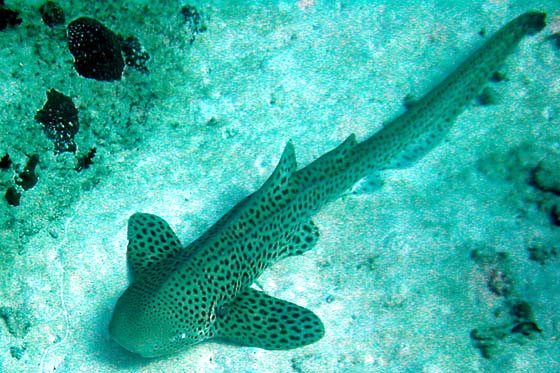
Leopard shark at the Similan Islands, Thailand
The diving is quite varied. Some dive sites feature huge, submerged granite boulders, some of which have swim-throughs. Other sites consist of large coral gardens. On my last trip I was lucky enough to see Manta rays at Koh Bon although visibility wasn't good that day. Whale sharks visit the island and although they can turn up at any time the chances of seeing them are better in March and April when planktonic blooms form. I have seen different species of shark (pictured is a leopard shark), some very large moray eels and at the other end of the scale some very pretty nudibranchs, shrimps and small fish.
Technically the diving can be quite challenging involving fairly deep dives and some strong currents. I enjoyed my first visit but only having about half a dozen dives under my belt at the time I was out of my depth (literally as well as metaphorically) and my air consumption was not good resulting in some fairly short dives. One night dive on that first trip had to be aborted due to an extremely strong current.
On my last trip I ran into one uncomfortable situation even though at the time I felt quite confident about my diving. It involved a deep dive and a rapid descent. I was struggling to keep up with the group as they descended and was getting left further and further behind. I started to think what would happen if something went wrong with my equipment. I couldn't reach another diver, couldn't attract their attention and couldn't get back safely to the surface. These thoughts, combined with over-exertion as I tried to reach the other divers, all added up and I lost control of my breathing. It can be quite scary 30 meters underwater when you only have a regulator for air and that source can't give you what you need. I would not suggest going on a Similans diving trip if you haven't dived for a while.
Another thing to watch out for is decompression sickness. The most common type of diving trip to the Similans is by live aboard and on these trips there is frequent diving, a lot of it at depth. It is probably more of a concern to people working in the industry who do a lot more diving and someone was telling me in Khaolak that quite a few divemasters have ended up having treatment. Use a computer or diving tables and stay well within the safety limits.
Book Your Hotel In Khaolak
Koh Tao
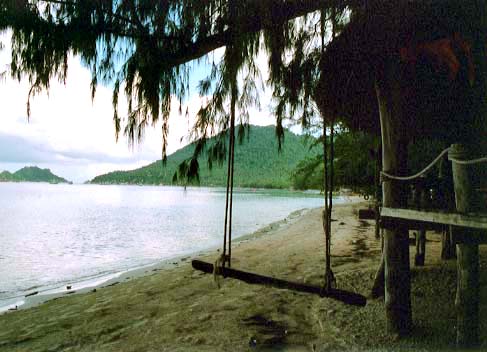
The old prison colony of Koh Tao
I really disliked Koh Tao and almost as soon as I arrived couldn't wait to leave. It's a small island and I think it used to be a penal colony. The main activity on Koh Tao is scuba diving and that should have been a good thing because I used to enjoy diving. It is the diving industry presence though that made me dislike the island.
When in Thailand I like to feel that I am in Thailand and that means lots of interaction with Thai people. Koh Tao attracts a lot of farangs who are looking for an easy life as divemasters or instructors in the day time and drinking, whatever, at night time.
I found the individual groups of people working at dive schools to be very 'clique' and they didn't like other farangs. I was ignored a lot of the time and made to feel most unwelcome. The accommodation I found wasn't up to much but seemed to be about average. There were swarms of mosquitoes and I heard that dengue fever was a big problem on the island with several foreigners working there having contracted it. However, this particular problem seems to have been hushed up because presumably it isn't very good for business.
I went diving and the diving wasn't that impressive. Nor were the divemasters. Many of them were quite immature, only wanting to talk about how little weight they carried and how little air they used on dives, or how much they drank last night. Yawwnnnnn. Your typical backpacker will probably love the place but I didn't and I won't be going back. It's very cheap to dive in Koh Tao and accommodation will often be included in dive course packages. I have never seen diving offered cheaper anywhere else.
Book Your Hotel In Koh Tao
Krabi

Backpackers
I first heard of Krabi in the early 1990's and that's when I should have gone. It took me until 2004 to actually spend some time there although I had passed through before. What I saw was exactly what I expected. Krabi is an entire province but most visitors who say they are going (or have been) to Krabi are only referring to a couple of beaches.
The main beach is at Ao Nang, and Rai Lay beach is also popular with backpackers who make the short boat trip from Ao Nang. They turn up with their backpacks and mooch around before going to another Thai beach which is exactly the same. Krabi has been on the standard backpacker trail for a long time and is popular also with package tourists. What I saw was exactly what I expected. There is a very fixed pattern with tourist Thailand.
The first thing that hit me were the high prices. The Krabi beaches are all about tourists and there isn't much of a local market. Prices are therefore set for tourists rather than locals and the locals are very aware of foreign costs of living and the spending power of tourists. Many businesses such as dive shops and restaurants are part farang owned and that is another factor that causes high prices.
A 25 minute tuk-tuk ride from the bus station to the beach set me back Bt300. After taking three-hour train rides for Bt18 and 10 minute tuk-tuk rides for Bt10 this came as a bit of a shock. However, there weren't many other options so the tuk-tuk driver had a definite advantage.
Even small items like bottled water which I normally pay Bt13 for were Bt30 in Ao Nang minimarts. Internet usage was Bt1 per minute - Bt60 an hour. It doesn't seem a lot but I pay Bt20 an hour. Some places charge Bt15 and there are shops in Bangkok offering one hour for Bt10. Compared to Europe the prices aren't expensive but after living in provincial Thailand for almost a year I was horrified. The Thais owning businesses there must be getting very rich.
There is a small part of 'real' Thailand in Ao Nang. I found a few food stalls on the street and a small hawker centre which were quite authentic with authentic Thai prices but generally it is a tourist ghetto. The businesses along the beach road are the usual travel agencies, souvenir shops, (expensive) massage shops and, worst of all, Indian bloody tailors. My patience was tested to the extreme every time an Indian tried to get me into his shop to buy a suit.
Rai Lay beach is every Westerner's idea of what a tropical beach 'paradise' should look like. The limestone karst formations that jut out of the ground and out of the sea are quite breathtaking. The beaches are clean and palm fringed and the sea looks inviting. I have to admit that it was very pretty but after a couple of hours I was bored rigid.
Whereas scuba diving is big in other parts of Thailand the big outdoors activity in Krabi is sea kayaking. It's a nice way to see the local landscape but hard work. You need to cover up as well as the sun is brutal.
Ao Nang disappointed me. In Thailand there are sights, sounds and smells that are so typically Thai but somehow in Ao Nang these were all missing. To me it was a typical Thai tourist destination where the Thais can charge foreigners three, four or five times what they would normally get. Most tourists haven't got a clue about prices in Thailand, or it is inconsequential, so they just hand over the money.
I was constantly hassled to buy excursions and many Thais have become greedy. I tried to joke with a few of them, as I do elsewhere in the country, but they just got annoyed because I didn't want to hand my money over. A sad sight in the evenings were women from Chiang Mai dressed up in hill tribe costumes peddling their wares on the street to get some of the tourist cash. Krabi beaches obviously appeal to a lot of foreigners but not this one.
Saying all that though, Ao Nang is infinitely more pleasant than somewhere like Patong in Phuket or Pattaya.
April 2010 update: I've just been on another trip to Krabi, and it was a lot better than the first time I went.

Maritime Park and Spa Resort, Krabi, Thailand
I hired a car and drove there. This gave me a lot more flexibility, and by driving myself I avoided the normal tourist resort rip-offs. It was a good trip.
I went in the low season at a time when Bangkok was having serious political issues. As a result, there were hardly any tourists. I stayed at the Maritime Park & Spa Resort, located a little way from the main town.
I got a good rate and the hotel is very pleasant with beautiful grounds. One downside at the hotel is that there is a serious mosquito problem if you go outside after dark. Not only are there swarms of mosquitoes, but they are aggressive and I noticed some Aedes mosquitoes which carry dengue. Be careful; mosquitoes are the most dangerous creatures on earth.
Krabi is a stunningly beautiful province. It was great having a car and being able to get off the beaten track. The most boring part was driving down to Ao Nang. Farangs are obsessed with beaches but I always find that in Thailand these are the most boring places.
Krabi attracts farangs but most of them head for the beach. It also attracts a different kind of farang to the type you find in Pattaya and Patong. There was no obvious sex industry in Krabi as there is at other toursit resorts.
The food there is great. I was able to get real authentic Italian pizza, and the feta cheese salad with olive oil and balsamic vinegar was the best I'd eaten since I left the UK.

Mangrove forest walkway, Krabi, Thailand
The Krabi mangroves look to be in good shape and you can hire a boat to take you around. There is also a walkway that allows you to walk into the mangroves.
Thailand is a tropical country but most of the time (apart from the heat) I don't feel as if I am living in the tropics. However, once inside the mangroves it feels totally tropical.
Krabi is a well-known area for birds. The Gurney's Pitta - one of the rarest birds in the world - can be seen in Krabi. I was hoping to see more birds than I did. They could be heard in the mangroves but I only saw a couple.
Book Your Hotel In Krabi
Mae Sot
I created a separate page about Mae Sot. It includes the photos below plus some additional ones.

The Thai/Burmese border at Mae Sot, Thailand
Mae Sot is one of the most interesting parts of Thailand I have ever visited. It has yet to be ruined by mass tourism (as have so many other places in Thailand) but there are signs that this could happen soon.
If, by the time you get to Mae Sot, you find that an Indian tailor shop calling itself "something Armani" has opened ... then you arrived too late.
Mae Sot is close to the Burmese border and like every other border town in Thailand there is lots of cross-border trade. As in other border towns in Thailand, much of this trade is illegal but bribes are paid and there is lots of looking the other way.

Crossing from Burma to Thailand in Mae Sot
Because of the political situation in Burma, activity on the Thai/Burmese border is probably a little more active than on other borders.
Mae Sot town is fairly small and if you are familiar with Thailand you realise immediately that it is very different to most Thai towns. This is because the town is mostly populated with Burmese. They dress differently to Thais and the women wear some kind of a paste on their faces.
As well as Buddhist Burmese, there are also a lot of Muslim Burmese in Mae Sot and naturally there is a mosque. Some Burmese are in Thailand as illegal immigrants whereas others have official refugee status.

Burmese girl, Mae Sot, Thailand
A little out of town is the Thai/Burmese friendship bridge that connects the two countries. It is possible to cross into Burma for the day to visit the town of Myawadi or just to get a passport stamp.
However, what goes on around the river that forms the border is far more interesting. You will see thousands of Burmese crossing the river in boats and on large inner tubes. This is all illegal, of course, but the Thai border guards ignore all the comings and goings.
Large trucks arrive constantly carrying all kinds of goods (fizzy drinks to used cars, and everything in between) which are loaded on to small boats and sent across the river to Burma. Burmese immigration officials take bribes to allow entry.

Burmese child, Mae Sot, Thailand
On the Thai side of the river are illegal clothes factories with hundreds of Burmese workers who are paid about Bt3,500 a month for working every day from 8am to 9pm. Money is paid 'under the table' and thus no action is taken against these businesses.
It's almost slave labour but at least the Burmese earn something. Without this illegal activity they would have nothing.
There is an island in the river which is a kind of no-man's land and Burmese refugees have built slum dwellings there. You will find Burmese vendors selling cheap cigarettes and Viagra in this area.

Refugee slums, Mae Sot, Thailand
I hired a Burmese guy to show me around. He gave me loads of information and translated for me. I could only communicate to the Burmese people this way as they didn't appear to be able to speak English and I can't speak a word of Burmese (although a few of the Burmese spoke Thai so we could communicate that way).
There are lots of NGOs working in this area who provide assistance to the Burmese, such as clinics and schools. They do a good job but it is sad that the only assistance comes from voluntary organisations. Governments do very little.
Western governments have tried to apply sanctions to Burma but when you see how much trade is being done with Asian countries (legally and illegally) you can understand why these sanctions are useless.

Viagra sellers on the Thai/Burmese border, Mae Sot, Thailand
Western powers should instead put pressure on Asian countries that deal with Burma, or take more serious action.
Of course, the reality is that if sanctions were applied effectively then the poorest Burmese people would be hurt most and the generals in the military dictatorship would still continue living in luxury.
Burma is a human tragedy but it is one that is easy to forget. Most foreigners only think about Burma when the media focuses on the country. It isn't until you visit places such as Mae Sot where you can witness what goes on every day that you realise how bad life is for ordinary Burmese people.
Book Your Hotel In Mae Sot
Nakhon Pathom
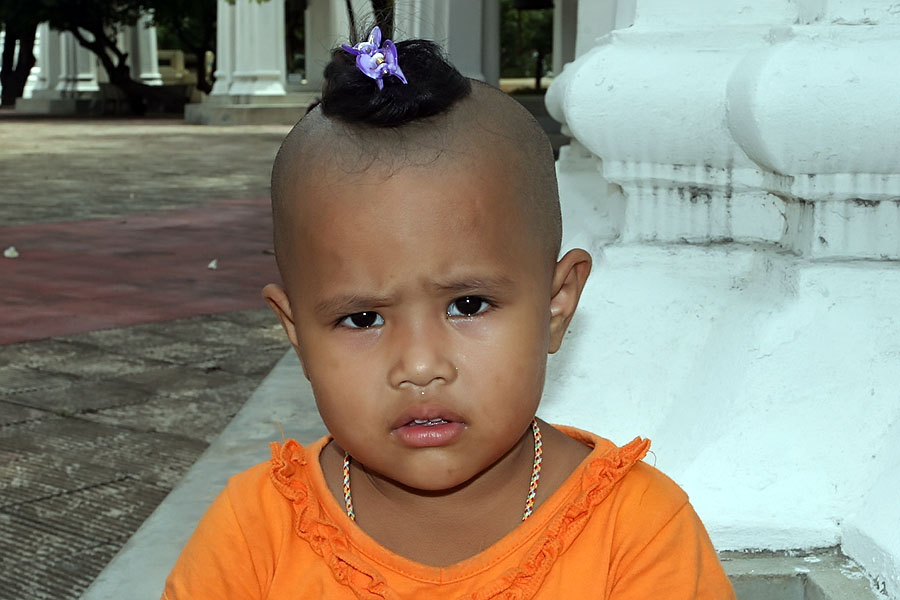
Young Thai boy with a traditional topknot at Nakhon Pathom, Thailand
I get a 'gut feeling' about new places I visit quite quickly, sometimes good and sometimes not so good. Before I visited Nakhon Pathom I had never heard of it and therefore had no time to read up on it or make any preconceived judgments. I am fortunate enough to have some friends in Bangkok with a car and last time I was there they drove me around to show me things I hadn't seen before. One of the places they wanted to take me to was Nakhon Pathom.
When we arrived my gut feeling was very good. The main attraction is Phra Pathom Chedi, a huge Chedi which (according to Lonely Planet) is the tallest Buddhist monument in the world. Nakhon Pathom is also a university town, being the home of a Silpakorn University campus. It's busy without being too crowded and the streets are wide and open giving a feeling of spaciousness. I was only there a day but I got the impression it was somewhere I would be able to live in quite comfortably.
Book Your Hotel In Nakhon Pathom
Nakhon Sri Thammarat
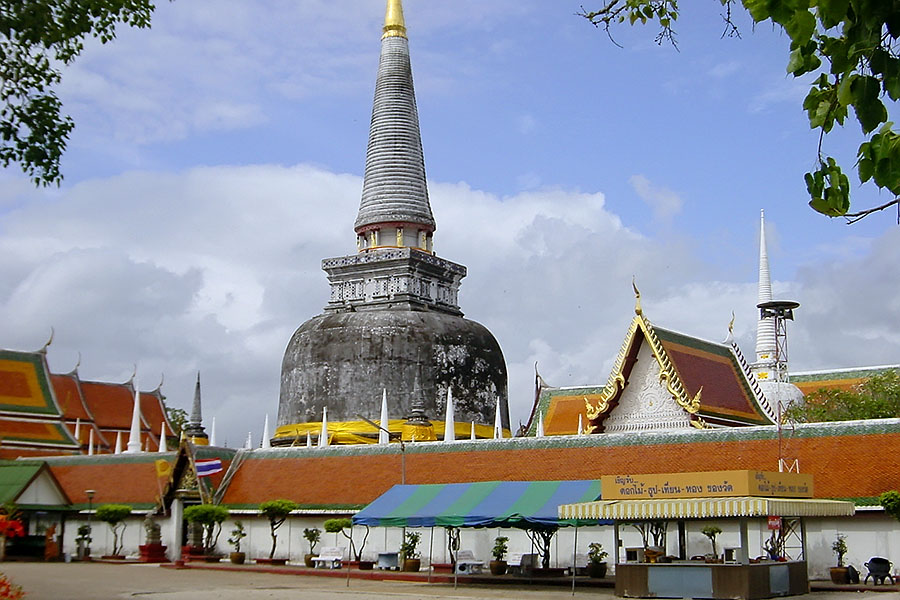
Nakhon Sri Thammarat ... it's just like being in Thailand
I have visited this important southern Thai city many times - see my Nakhon Sri Thammarat page.
It is very, very different to the popular tourist areas of Thailand and many foreigners who aren't familiar with Thailand will probably feel a little uncomfortable there. It's not a big tourist destination, but the beach resort of Khanom is growing. I like Nakhon Sri Thammarat because it is real Thailand and not an artificial tourist resort. Incidentally, it is where my wife was born.
Book Your Hotel In Nakhon Sri Thammarat
Pak Khat
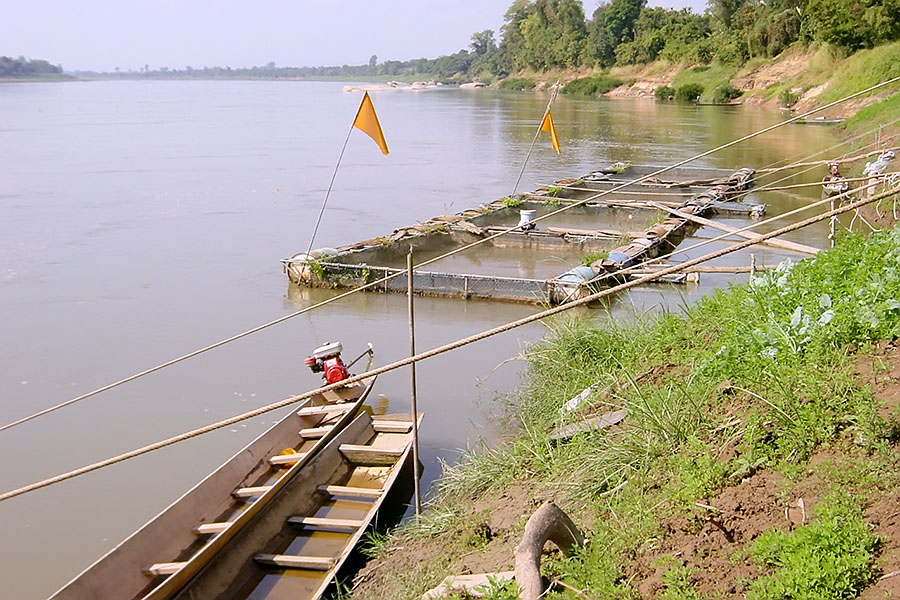
The Mekong river on the Thai/Laos border
I met and fell for a totally unsuitable girl and while I was seeing her arranged to accompany her on a trip back to the village in Isaan where she came from. At first she told me it was Nong Khai but it turned out to be a small place north-east of Nong Khai on the Mekong with Laos on the other side of the river.
My reasons for going were twofold. First, the opportunity to spend time with her was most appealing. Secondly, I was very intrigued with this area of Thailand. I'd met some good looking girls in other parts of the country who came from Isaan and some of the Thai dishes I enjoyed were from this region. I didn't know what to expect.
It was certainly an eye-opener. Isaan is the poorest area of Thailand. People there live in the most basic of conditions, some of the dwellings I saw were no more than shacks. There are even more stray dogs running around than in the rest of Thailand and chickens everywhere. Sticky rice (khao niaow) is the staple and the smell of sticky rice, which I didn't find at all pleasant, fills the air. Som-Tum, the spicy papaya salad eaten in Thailand, is very popular here but far more pungent and spicier than elsewhere. The people eat with their fingers, all sitting around, or on, a low table picking up sticky rice and other food with their hands.
Although the people from this region are the poorest in Thailand they don't look unhappy. There is a strong community feeling and everyone knows everyone else. I stayed at my girl's parents house which was totally open. There is no concept of a front door or any security and anyone can just walk in from the road. However, I didn't have any concerns about leaving anything in the house. For entertainment people gather together drinking beer, singing along to Karaoke videos, eating, talking and laughing. In Pak Khat a lot of the young males are involved with row boat races on long, low-slung boats. They practice regularly and compete in inter-village races. I got involved in one of the practice sessions, much to the amusement of the villagers, and it was one of the most physically exerting things I have done in a long time.
The community spirit I mentioned runs very deep. I think it is the only way that people can survive - by relying on help from each other. The state isn't going to help them and they don't have the opportunity to earn decent salaries. If someone is building a new house the other villages all muck in to help and presumably then everyone is expected to do the same. It's a totally different way of life to what I know and even to what exists in the rest of Thailand.
Regarding the girls. Because I had met many good looking girls elsewhere in Thailand from this region I imagined that there would be lots of good looking girls there. That is not the case. People in the region are extremely poor and ways to make money are minimal. A pretty girl is a valuable asset as she can earn money from tourists so what happens is that almost every pretty girl leaves at quite a young age to earn money in places like Bangkok, Phuket, Samui, Pattaya, etc. Whatever she earns she will send a good proportion of it home to support her family.
Book Your Hotel In Nong Khai
Pattaya
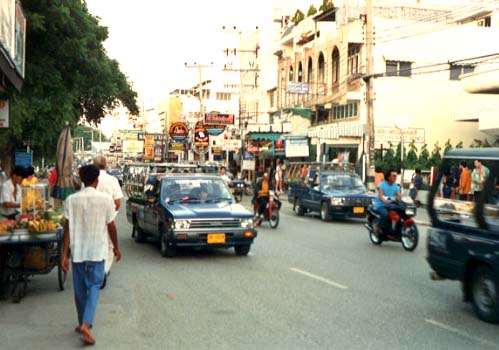
Pattaya, circa 1987
Pattaya is one of those places that people either love or hate. I first visited Pattaya in 1987 and loved it. I returned in 1992, but Pattaya had changed beyond recognition and I hated it. I vowed never to return.
I continued hating it for many years, but a certain set of circumstances involving my family saw me booking a hotel and returning to Pattaya again in 2016. I couldn't believe that I was actually going back to Pattaya. I had read a lot about Pattaya's attempts to become more family-friendly and I stayed in a very pleasant, large, family-friendly hotel.
It's still not a place where I would choose to live, but it's not as bad as it was a few years ago and some parts now are very suitable for families and young children.
For more thoughts, impressions, hotos and information, see:
Pattaya Travelogue And Mini Guide
Book Your Hotel In Pattaya
Phang-Nga

Phang-Nga has some fascinating natural scenery
I've only stopped in Phang-Nga once on a day trip from Khaolak, although I have driven through several times on the way to Phuket. Along with a couple of friends we hired a long-tail boat to explore the mangroves and visit some islands, including 'James Bond' island. It's a very scenic area with limestone cliffs and huge rocks that soar unexpectedly straight out of the sea. There is a stilted Muslim village but nowadays it appears to be no more than a tourist trap, just somewhere to serve lunch to the tourists who visit 'James Bond' island in their droves and where the locals try to sell tourists a few souvenirs.
Near the bay is a Buddhist temple in a cave that is home to a colony of monkeys. Food for the monkeys is sold there and the furry beasts don't seem to be too aggressive, as I've found they can be elsewhere. I got quite a kick out of this place but I can't remember exactly where it was.
Book Your Hotel In Phang-Nga
Phattalung
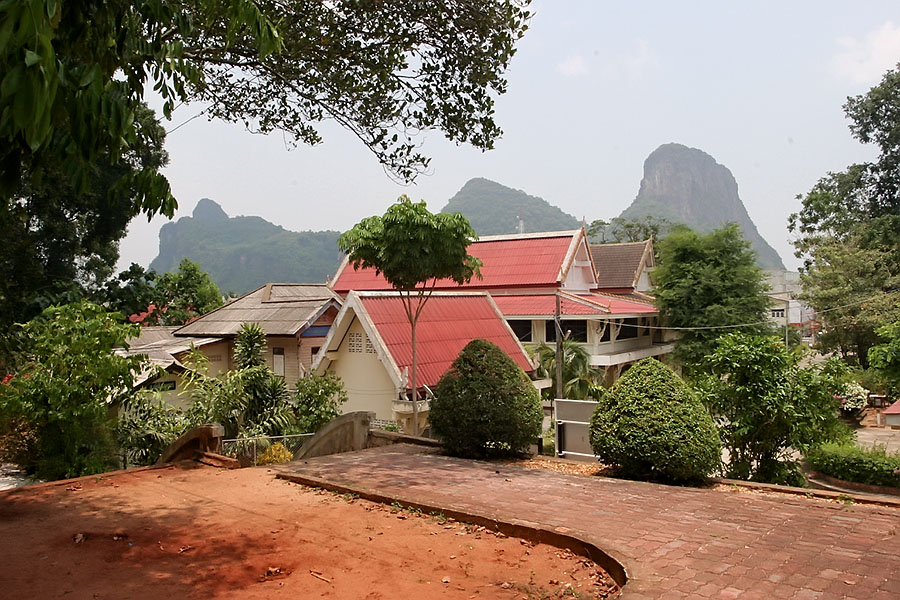
There is hardly a foreign tourist to be found in Phattalung
Love it or hate it, before I go somewhere new in Thailand I normally take a look to see what Lonely Planet says before I go. This wasn't possible with Phattalung because LP don't include a Phattalung entry. The inland sea that starts off in Songkhla province in the south extends northwards into Phattalung province and from my map it would appear that there are several national parks, bird and wildlife sanctuaries in the area.
The towering limestone karst formations, more common in Krabi and Phang Nga provinces, start to appear in Phattalung adding interest to the landscape. In travel guide book terms there isn't much in the town of Phattalung. Of note though is Wat Khuha Sawan, or more precisely, the cave at the back of the Wat known as Tham Khuha Sawan.
The Wat was established in the Ayuthaya period somewhere in between the 8th and 10th centuries. It was the first temple in Phattalung to be upgraded to royal temple status. It's a pleasant place with good views of the surrounding area but the cave is the best part.
Because of the Wat's royal status there are monograms of the current King and Queen and the much revered King Rama V inscribed on the walls at the front of the cave. The cave contains a reclining Buddha, a stupa and several other Buddha images. It's an interesting place for visiting tourists but a very holy place for Buddhists so should be treated with great respect.
What I liked most about Phattalung was what it hasn't got. I fondly recall my first visit to Thailand in the 80's and compare it to the Thailand of today now that mass tourism, globalisation, greed and the adoption of the American capitalist system have found their way into the Kingdom.
Many parts of the country have been ruined but there are still little pockets that remain untouched and for me it was like a nostalgic trip back in time. People smiled at me and spoke because they wanted to be friendly and not because they were after money. Coming from Hat Yai, as I did, there were some pretty stark contrasts that were very refreshing.
Phattalung has no backpacker guest houses (I spotted just one hotel), no stereotype backpackers, no seedy farang sex tourists, no seedy Malaysian sex tourists (no regular tourist trade, in fact) no massage and foot massage shops every 10 yards with pretty girls who don't understand Thai massage (I saw one genuine Thai massage facility), no Western junk food chain restaurants, no brothels disguised as Karaoke bars, no prostitutes strutting around in tight clothes and 6 inch heels.
What I did see a lot of, surprisingly, were Chinese gold shops (are there any gold shops in Thailand that aren't Chinese owned?). Of course, there is a local fresh market and the usual Thai shops and restaurants. I barely saw a word of written English and although I met a few people who spoke some English, many didn't. It helps to know a little Thai if visiting Phattalung.
My second visit to Phattalung was to visit the inland sea (Thale Noi) and bird sanctuary. This involved an overnight stop in order to make an early start the next day. On this trip I discovered a second hotel and apparently there is a third but that's it. Phattalung is not really geared up for lots of tourists and that is a blessing.
I love being in parts of Thailand where there aren't crowds of tourists but one thing I find slightly annoying (and quite rude, actually) is to keep being pointed out by locals. I really don't understand why they feel it is necessary to tap their friends on the shoulder and mention they have seen a farang. Depending on my mood I'll either let it go or walk over to them and ask them, in Thai, what they want.
Thale Noi is a wonderful (and so far, unspoilt) area of Thailand. When the Tourist Authority of Thailand (TAT) changed their advertising campaign from 'Amazing Thailand' to 'Unseen Thailand' I guess this is the kind of place they had in mind.
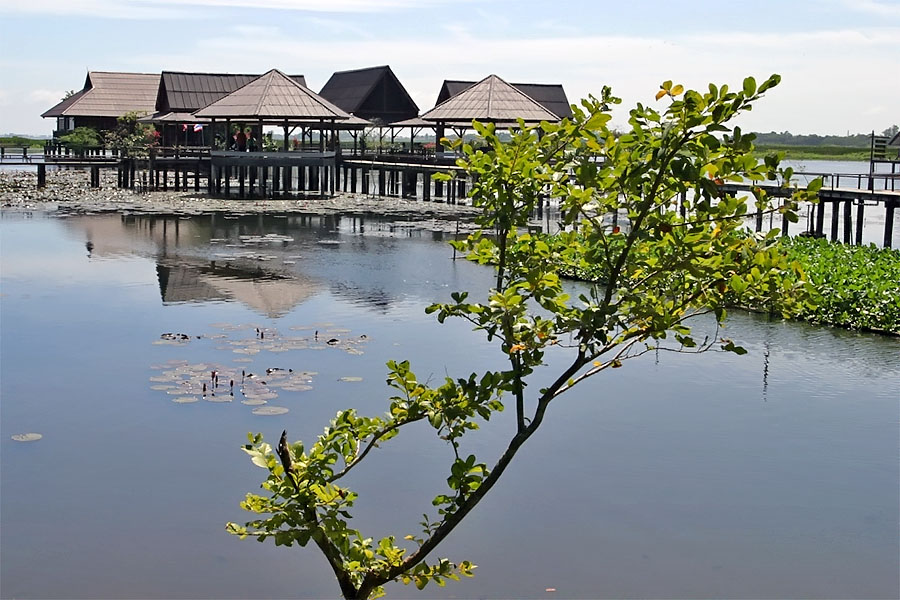
Visitor accommodation at Thale Noi, Phattalung, Thailand
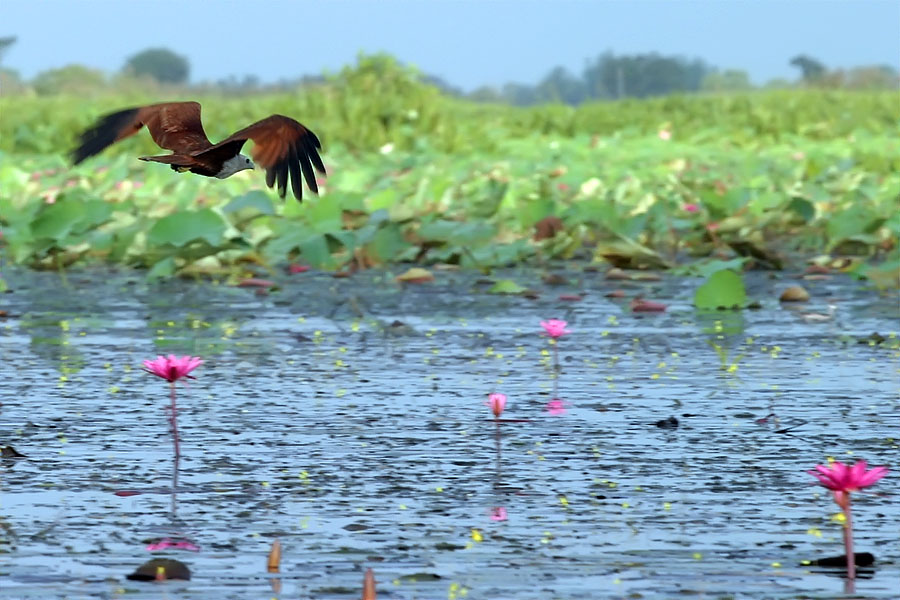
Brahminy kite, Phattalung, Thailand
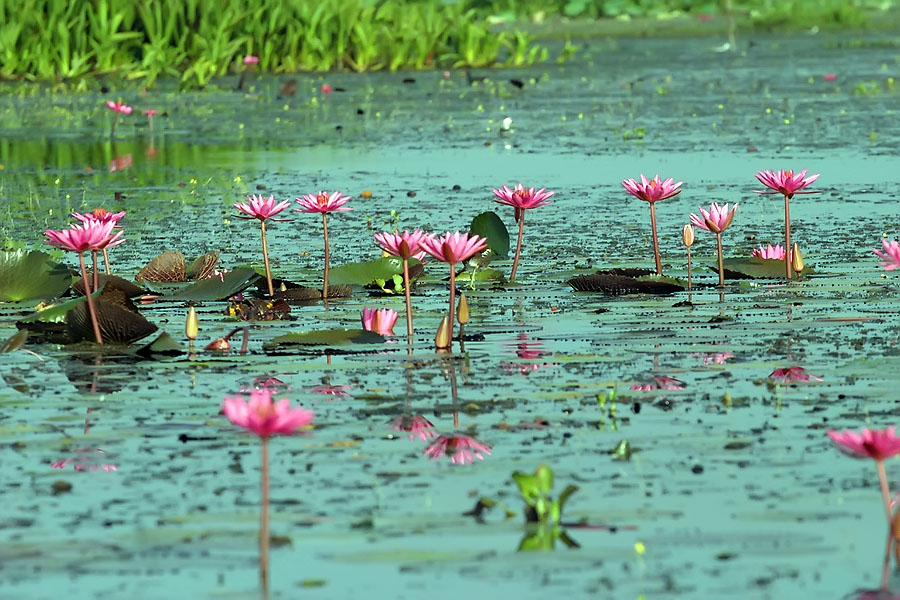
Millions of lotus flowers carpet the lake at Thale Noi, Phattalung, Thailand
For more photos and details about Thale Noi click the link to go to my Hat Yai page.
I have also written a separate guide to Phattalung.
Book Your Hotel In Phattalung

